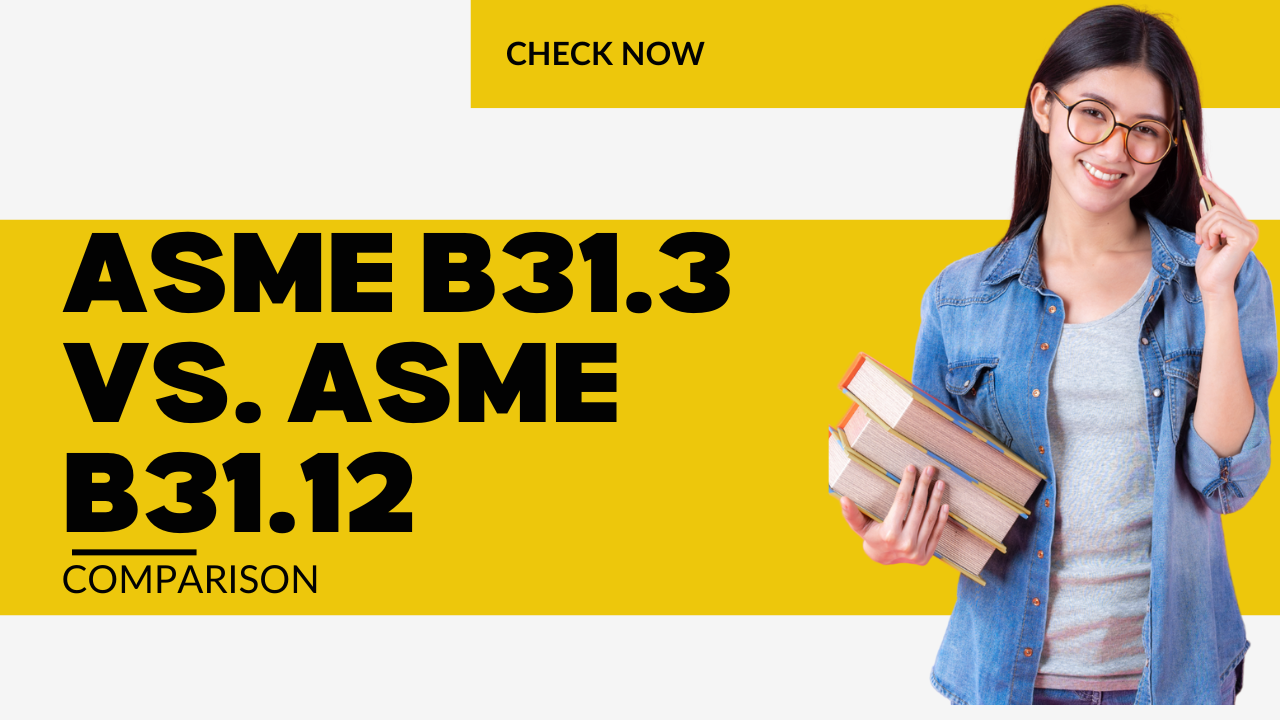Introduction
In the world of engineering and construction, standards and codes play a pivotal role in ensuring safety, reliability, and efficiency. ASME, the American Society of Mechanical Engineers, has developed various codes that guide the design, fabrication, and inspection of piping systems. Two prominent codes, ASME B31.3 and ASME B31.12, often spark discussions due to their unique applications and scope. In this article, we’ll delve into the differences and similarities between ASME B31.3 and ASME B31.12, shedding light on their significance across industries.
Table of Contents
ASME B31.3 vs. ASME B31.12: Exploring the Distinctions
ASME B31.3: The Piping and Process Piping Code
ASME B31.3, often referred to as the “Process Piping Code,” is a comprehensive set of guidelines specifically designed for piping systems in chemical, petrochemical, pharmaceutical, and other process industries. This code provides detailed instructions for the design, materials selection, fabrication, assembly, testing, and inspection of process piping. It ensures the integrity of systems that transport fluids or gases, maintaining safety and preventing leaks or failures that could lead to hazardous situations.
ASME B31.12: The Hydrogen Piping and Pipelines Code
ASME B31.12, on the other hand, is known as the “Hydrogen Piping and Pipelines Code.” It addresses the unique challenges posed by hydrogen transportation and distribution systems. Given the increasing interest in hydrogen as a clean energy source, this code has gained significance. ASME B31.12 covers design, materials, fabrication, inspection, testing, operation, and maintenance of piping and pipelines for hydrogen gas. The code ensures the safe utilization of hydrogen in various applications, including fuel cells and industrial processes.
Don’t miss the Complete Course on Piping Engineering: Check Now
By EPCLand.com
Application Scope: Where They Differ
The primary difference between ASME B31.3 and ASME B31.12 lies in their application scope. ASME B31.3 focuses on a wide array of process industries, dealing with various fluids and gases beyond hydrogen. In contrast, ASME B31.12 narrows its focus to hydrogen-specific systems, acknowledging the unique characteristics and challenges associated with hydrogen transport and usage.
Material Considerations: Compatibility and Safety
When it comes to materials, both codes emphasize compatibility, corrosion resistance, and mechanical properties. However, ASME B31.12 places special emphasis on materials suitable for hydrogen service due to hydrogen’s unique effects on certain metals. This ensures the safe and reliable operation of hydrogen systems without compromising integrity.
Design and Construction Similarities
While the codes cater to different industries, they share similarities in design and construction principles. Both emphasize proper design, welding procedures, non-destructive testing, and quality control to ensure the longevity and safety of piping systems. Whether it’s minimizing stress concentrations in ASME B31.3 or addressing hydrogen embrittlement concerns in ASME B31.12, these codes prioritize meticulous engineering.
Code Evolution: Staying Relevant
ASME codes continuously evolve to adapt to technological advancements and industry needs. ASME B31.3 has seen revisions to address new materials, processes, and safety practices. Similarly, ASME B31.12 has undergone updates to reflect the latest research on hydrogen behavior and its interaction with materials. These revisions underscore the commitment of ASME to keeping piping systems safe, efficient, and up-to-date.
FAQs
Q: Are ASME B31.3 and ASME B31.12 interchangeable? A: No, these codes serve distinct purposes and cater to different industries. ASME B31.3 focuses on process piping in various sectors, while ASME B31.12 is tailored for hydrogen-related systems.
Q: Can ASME B31.3 be used for hydrogen piping? A: While ASME B31.3 covers a wide range of fluids, it may not fully address hydrogen’s unique characteristics. ASME B31.12 provides specialized guidelines for hydrogen transport.
Q: Is hydrogen piping significantly different from regular process piping? A: Yes, hydrogen’s properties, such as embrittlement potential, demand specific considerations. ASME B31.12 accounts for these differences to ensure safe hydrogen systems.
Q: Which industries benefit most from ASME B31.3? A: ASME B31.3 is crucial for process industries like chemicals, pharmaceuticals, and petrochemicals that transport various fluids and gases.
Q: How does ASME B31.12 contribute to the hydrogen economy? A: ASME B31.12 facilitates the safe transport of hydrogen, promoting its use in fuel cells, industrial processes, and emerging clean energy applications.
Q: Can following these codes eliminate all risks in piping systems? A: While ASME codes significantly mitigate risks, proper implementation, ongoing maintenance, and adherence to safety protocols remain essential.
Conclusion
In the realm of engineering codes, ASME B31.3 and ASME B31.12 stand as cornerstones, guiding professionals in ensuring the safe and efficient operation of piping systems. While ASME B31.3 covers a broad spectrum of process industries, ASME B31.12 takes the spotlight in addressing the complexities of hydrogen transport. By upholding rigorous standards, these codes pave the way for innovation, safety, and reliability in their respective fields.
Recommended courses (Published on EPCLand):
- Basics of Piping Engineering
- Piping Layout Engineering
- Piping Material Engineering
- Piping Stress Analysis
- Complete Course on Piping Engineering
- Material Requisitions
- Piping Material Specifications
- Valve Material Specifications
Related Video
Attempt Quiz
Question 1:
What is the main focus of ASME B31.3?
Explanation: ASME B31.3 focuses on the design, construction, and operation of pressure piping systems in power and industrial plants, including criteria for materials, components, fabrication, assembly, erection, examination, inspection, testing, operation, and maintenance.
Question 2:
What type of piping systems does ASME B31.12 primarily address?
Explanation: ASME B31.12 primarily addresses the design and construction of hydrogen piping and pipeline systems, including materials, design, fabrication, assembly, erection, testing, inspection, operation, and maintenance.
Question 3:
Which of the following industries is most likely to utilize ASME B31.3?
Explanation: The chemical and petrochemical industry is most likely to utilize ASME B31.3 for the design and construction of pressure piping systems in their plants.
Question 4:
What is the key difference between ASME B31.3 and ASME B31.12?
Explanation: The key difference is that ASME B31.3 primarily addresses process piping in power and industrial plants, while ASME B31.12 specifically focuses on hydrogen piping systems.
Question 5:
Which of the following standards would be relevant for designing a hydrogen distribution system for fuel cell vehicles?
Explanation: ASME B31.12 would be relevant for designing a hydrogen distribution system for fuel cell vehicles due to its focus on hydrogen piping systems.



